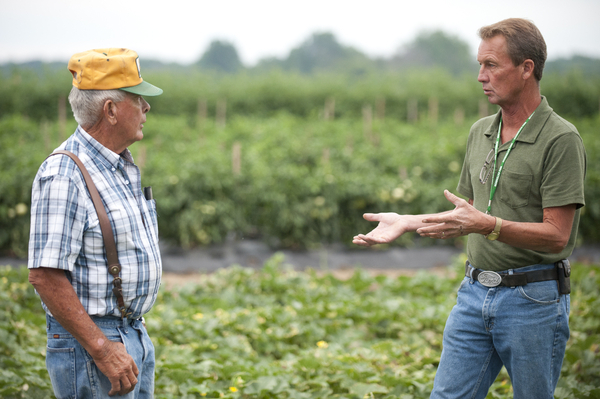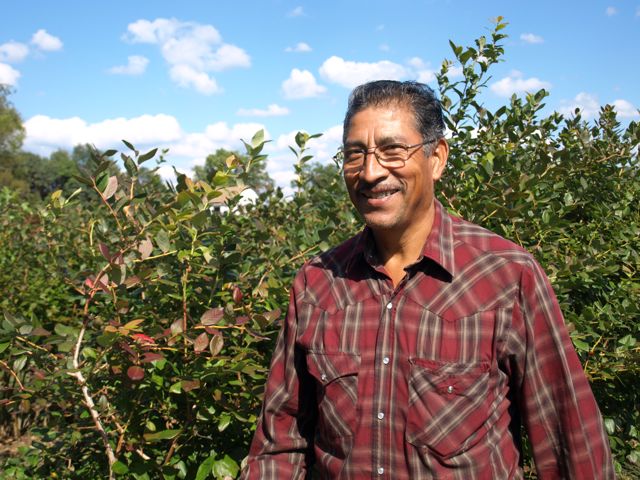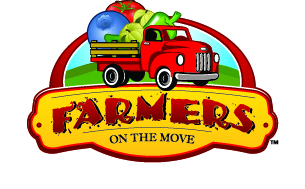MAKE TWICE THE IMPACT
Help us support healthier families, stronger local economies, and a more resilient food system for us all.
Your gift today will be matched thanks to the Hamp Family Fund.
October 7, 2011
Source: Michigan Farm News, October 15, 2011 print edition
Author: Patty Cantrell and Bob Heuer, Fair Food Network
Macomb County vegetable grower George DeBruyn has had a busy season supplying supermarkets and his own produce market north of metropolitan Detroit. His upcoming plans elicit a chuckle.
“Four schools have called me so far this year to buy our produce,” he says with a glint in his blue eyes. “One has a large greenhouse. So I’m going to school this fall to teach kids how to grow and harvest.”

George DeBruyn (right) visits with a fellow farmer during an MSU Extension workshop at DeBruyn’s farm.
Photo credit: Gary Howe
Farm-to-school sales received a boost recently from a U.S. Department of Agriculture decision allowing Michigan schools greater flexibility in produce purchasing. Less rigid federal requirements could mean new opportunities for many, such as DeBruyn’s southeast Michigan community of third- and fourth-generation immigrant farmers.
Such shifts bolster DeBruyn’s business opportunities and his faith in a neighborly economy. “When I go Christmas shopping, I go to Mom and Pop stores. I want to support them. They support me.”
This ethic of taking care of neighbors, land, and the future is at the heart of the local food movement. Proponents include non-profit organizations like the Wallace Center at Winrock International, which hosts the National Good Food Network. NGFN’s monthly webinars garner a national audience seeking market-based solutions to problems like rural and urban areas that lack access to fresh, healthy foods and the need to improve working conditions for many in the food industry.
The country’s largest growers, distributors, and processors acknowledge a legitimate market force in the making. The Produce Marketing Association’s (PMA) recent national conference highlighted inter-related trends of “sustainability” and “locally grown” that are re-shaping the food supply chain. The PMA encouraged members to begin thinking of achieving the “triple bottom line” of people, planet, and profit.
Consumer demand for new taste, transparency, and trust in their food is in fact spurring a new business model – a food value chain —that some entrepreneurs are embracing. Price and convenience remain key variables. Yet another essential factor is the farmer’s story, says Michigan State University Product Center supply chain specialist Matt Birbeck. “Consumers these days are looking beyond the product and focusing far more on who you are and what you do.”
Examples of this shift abound. Food service orders accommodate more varieties of apples grown by Michigan farms instead of just the Red and Golden Delicious from Western growers. Distributors seek growers who can brand their story. “Food hubs” are emerging to aggregate local products for regional sale.
The innovation and investment could help revitalize the mid-scale farming demographic. Often too large for farmers markets and too small for big success in global commodity markets, it is these farmers “in the middle” who have an appealing story to sell.
Kevin Piscatello is a Chicago-based vice president of regional procurement for Sysco, the $40 billion food service distributor to restaurants and cafeterias. “We have always tried to drive costs out of the system by going from 20 (farm) invoices to one, and hitting a truck load,” he says. “Now we compete with jobbers, mom and pop distributors who create niches” and can afford to handle more suppliers.
Sysco is lining up local supply when available. Volume in a new Michigan ordering category (MIPROD) is increasing 20 percent per year. This summer, Michigan radishes supplanted the Arizona product for six weeks.
Paul Baumgartner is food service director for Grand Rapids Public Schools. He’s talked with distributors who want a piece of Michigan schools’ new produce spending authority. He says: “What it’s going to be is local first, regional second, domestic third.”
Demand from small and large distributors alike is prompting some farms to build cooperatives and their own brands. Consider “Farmers on the Move.” This southwest Michigan cooperative consists of 13 Hispanic blueberry growers like Pedro Bautista of Van Buren County. He says the co-op intends to add more growers and products: “We hope in the next few years that many who are still doing this on weekends will be working 100 percent on their farms.”

Van Buren County blueberry grower Pedro Bautista is one of the founders of the new Farmers on the Move cooperative and brand.
Photo credit: Patty Cantrell
“Beyond providing a quality product, which is a given, it’s the people who grow the blueberry that make the difference,” says Tyler Smith, account executive at Newhall Klein Inc. While developing the cooperative’s brand, this Kalamazoo firm found that the farmers’ contribution to Michigan farmland preservation has significant consumer appeal.

No wonder elected officials like Michigan Governor Rick Snyder are advancing plans to link public health and agricultural vitality through such initiatives as farm-to-school.
Michigan Department of Agriculture and Rural Development Director Keith Creagh talked up implementation strategy on Lansing’s Channel 6 News. “One of the programs we’ll spend more time, energy and effort on is something called Local Food Hubs,” he says. Food hubs are about “marrying businesses and consumers and farmers to make sure you have that integration of systems to supply food locally."
Michigan has several food hubs in the works. Grand Rapids is planning a year-round public market that will include wholesale. Detroit’s Eastern Market, which does strong retail business on Tuesdays and Saturdays, is building up its wholesale traffic. The 43-acre food business district is 120 years old. It remains a key outlet for some wholesale produce farms but it’s not like it was a generation ago. As Eastern Market’s wholesale manager, Christine Quane’s job is to reinvigorate the regional food supply by linking producers to larger scale local buyers. “People want that local product, and it’s becoming more and more important,” she says. “We’re working to help the market catch up.”
Turn up the Volume is a Fair Food Network project to investigate local food market potential for Michigan growers, processors, and distributors. Patty Cantrell, Regional Food Solutions LLC, produces the series for the Fair Food Network with USDA Specialty Crop Block Grant support. See the full series on Facebook.